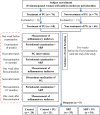The "double-edged" role of progesterone in periodontitis among perimenopausal women undergoing or not undergoing scaling and root planing
- PMID: 37645411
- PMCID: PMC10461080
- DOI: 10.3389/fendo.2023.1224763
The "double-edged" role of progesterone in periodontitis among perimenopausal women undergoing or not undergoing scaling and root planing
Abstract
Objective: Progesterone (PG) is an important sex steroid hormone commonly administered to protect the endometrium in perimenopausal women. The present study aimed to explore differential responses of periodontitis to PG in perimenopausal women who did or did not undergo scaling and root planing (SRP).
Methods: A total of 129 perimenopausal women with mild-to-moderate periodontitis were enrolled and underwent treatment as follows: SRP (n = 35); SRP + PG (n = 34); PG (n = 31); and no treatment (s) (n = 29). Pocket probing depth (PPD), clinical attachment level (CAL), sulcus bleeding index (SBI), and bleeding on probing (BOP) were measured using periodontal probes. Three inflammatory markers, including C-reactive protein (CRP), interleukin (IL)-6, and tumor necrosis factor-alpha (TNF-α) in gingival crevicular fluid (GCF) were measured using ELISA techniques.
Results: PPD, CAL, SBI, BOP, and levels of inflammatory factors in GCF were all significantly decreased in perimenopausal women with periodontitis after SRP. In patients who did not undergo SRP, 6 months of PG treatment significantly elevated PPD, SBI, BOP, and GCF levels of CRP, IL-6, and TNF-α. In contrast, PG exhibited inhibitory effects on periodontal inflammation in patients who underwent SRP, evidenced by significantly decreased BOP and IL-6, and slightly decreased SBI, CRP, and TNF-α. PG-induced changes dissipated 6 months after withdrawal of PG (at 12 months).
Conclusions: Among perimenopausal women with periodontitis, PG enhanced periodontal inflammation in the absence of SRP but inhibited periodontal inflammation in those who underwent SRP.
Keywords: inflammation; perimenopause; periodontitis; progesterone; scaling and root planning.
Copyright © 2023 Yan, Man, Lu, Cui, Niu and Qin.
Conflict of interest statement
The authors declare that the research was conducted in the absence of any commercial or financial relationships that could be construed as a potential conflict of interest.
Figures
Similar articles
-
Exogenous progesterone short-termly affects the periodontal environment in perimenopausal women.Oral Dis. 2023 May;29(4):1795-1801. doi: 10.1111/odi.14133. Epub 2022 Jan 23. Oral Dis. 2023. PMID: 35034421
-
Effect of locally delivered minocycline microspheres on markers of bone resorption.J Periodontol. 2002 Aug;73(8):835-42. doi: 10.1902/jop.2002.73.8.835. J Periodontol. 2002. PMID: 12211491 Clinical Trial.
-
Efficacy of scaling and root planning with and without adjunct Nd:YAG laser therapy on clinical periodontal parameters and gingival crevicular fluid interleukin 1-beta and tumor necrosis factor-alpha levels among patients with periodontal disease: A prospective randomized split-mouth clinical study.J Photochem Photobiol B. 2017 Apr;169:70-74. doi: 10.1016/j.jphotobiol.2017.03.001. Epub 2017 Mar 3. J Photochem Photobiol B. 2017. PMID: 28282558 Clinical Trial.
-
Clinical effect of azithromycin as an adjunct to non-surgical treatment of chronic periodontitis: a meta-analysis of randomized controlled clinical trials.J Periodontal Res. 2016 Jun;51(3):275-83. doi: 10.1111/jre.12319. Epub 2015 Sep 12. J Periodontal Res. 2016. PMID: 26362529 Review.
-
Systemic antibiotics adjuvants to scaling and root planing in type 2 diabetic and periodontitis individuals: Systematic review with network meta-analysis.Jpn Dent Sci Rev. 2023 Dec;59:167-178. doi: 10.1016/j.jdsr.2023.06.001. Epub 2023 Jun 18. Jpn Dent Sci Rev. 2023. PMID: 38152384 Free PMC article. Review.
References
Publication types
MeSH terms
Substances
LinkOut - more resources
Full Text Sources
Research Materials
Miscellaneous



